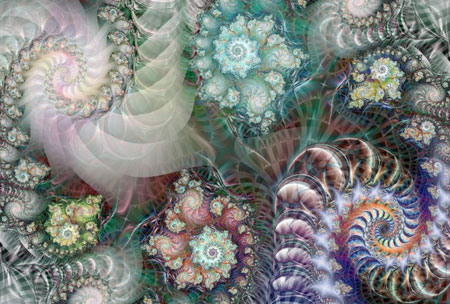
In mathematics, the Mandelbrot set, named after Benoît Mandelbrot, is a set of points in the complex plane, the boundary of which forms a fractal. Mathematically, the Mandelbrot set can be defined as the set of complex values of c for which the orbit of 0 under iteration of the complex quadratic polynomial zn+1 = zn2 + c remains bounded.[1] That is, a complex number, c, is in the Mandelbrot set if, when starting with z0=0 and applying the iteration repeatedly, the absolute value of zn never exceeds a certain number (that number depends on c) however large n gets.
For example, letting c = 1 gives the sequence 0, 1, 2, 5, 26,…, which tends to infinity. As this sequence is unbounded, 1 is not an element of the Mandelbrot set.On the other hand, c = i (where i is the square root of -1) gives the sequence 0, i, (−1 + i), −i, (−1 + i), −i…, which is bounded, and so i belongs to the Mandelbrot set.
When computed and graphed on the complex plane, the Mandelbrot Set is seen to have an elaborate boundary, which does not simplify at any given magnification. This qualifies the boundary as a fractal.
The Mandelbrot set has become popular outside mathematics both for its aesthetic appeal and for being a complicated structure arising from a simple definition. Benoît Mandelbrot and others worked hard to communicate this area of mathematics to the public.

Any theory of the universe has to address the growing list of new observations
At the least it should include a mechanism with the subtlety to make spatial fractals and the speed and strength to structure the vast universe we see.
Uniquely electromagnetic energy and its resultant force has these and other attributes.
It provides a compelling explanation for the flatness of structures, from atoms to galaxy walls.
The gathering of matter by Z-pinch nicely explains voids.
The ability to store energy in magnetic fields and to bring about nuclear fusion is powerful stuff.
Many of the intractable problems which beset cosmology look amenable to an electronic approach especially considering the various modes and frequencies of oscillation.
The universe appears to be fractal, cyclic and self- regenerating. Implied is that it is eternal and infinite.
heres a good example of the fractal nature of "infinity"
At the least it should include a mechanism with the subtlety to make spatial fractals and the speed and strength to structure the vast universe we see.
Uniquely electromagnetic energy and its resultant force has these and other attributes.
It provides a compelling explanation for the flatness of structures, from atoms to galaxy walls.
The gathering of matter by Z-pinch nicely explains voids.
The ability to store energy in magnetic fields and to bring about nuclear fusion is powerful stuff.
Many of the intractable problems which beset cosmology look amenable to an electronic approach especially considering the various modes and frequencies of oscillation.
The universe appears to be fractal, cyclic and self- regenerating. Implied is that it is eternal and infinite.
heres a good example of the fractal nature of "infinity"
No comments:
Post a Comment